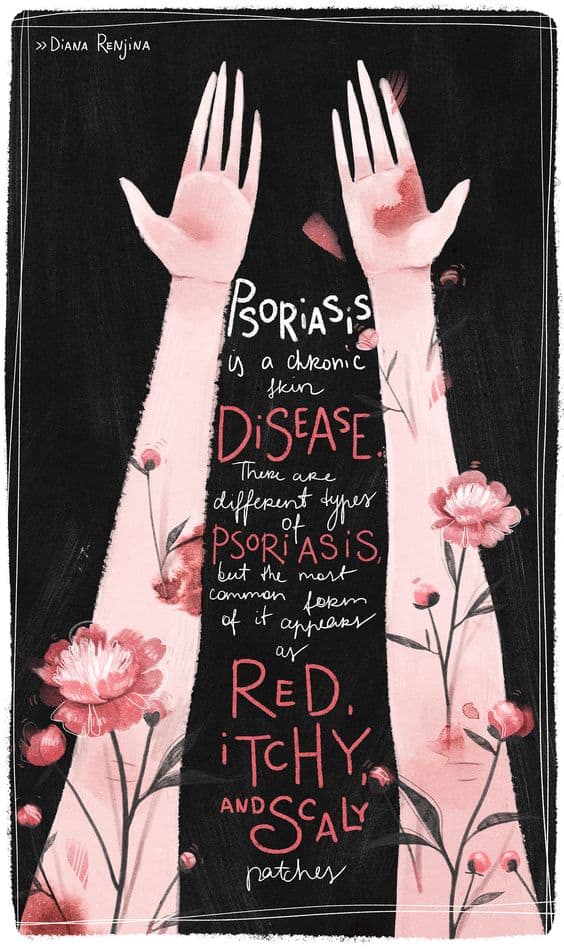Have questions about Psoriasis and want to understand it better? Well, we’ve got you covered! This skin condition is under our beauty microscope this week, so scroll down to read what exactly psoriasis is, the different types and the possible treatments for it:

What Is Psoriasis?
Psoriasis is a common, long-term skin disorder which causes red, uneven patches to appear on the skin that might burn, itch or sting. This occurs when skin cells multiply ten times faster than their normal rate. Normally, they grow deep into the skin and slowly rise to the surface, eventually falling off. In psoriasis however, they don’t have time to fall off, resulting in an accumulation of skin cells. The most common affected areas are the scalp, knees, elbows and lower back. These areas can go through cycles where they suddenly flare up for a few weeks or months, and then they might calm down and go into remission. Inflammation around these white scaly patches is common, and sometimes if handled roughly, can cause the skin to crack and bleed. The disease is not contagious and can affect more than one member of the family.
Types Of Psoriasis
There are generally 5 types of Psoriasis:
- Plaque Psoriasis: This is the most common kind, and amounts to 80% of Psoriasis cases. It includes red, inflamed and itchy patches that are usually covered with white flaky scales or plaques; these can bleed if cracked and it can be very painful.
- Guttate Psoriasis: This usually affects young children, and it causes teardrop shaped scaling lesions on the trunk arms or legs. Stress, usage of beta-blocker medications, bacterial infections like strep throat and tonsillitis, could trigger the skin disease. This is the second most common type of psoriasis.
- Pustular Psoriasis: This type is rare and causes red scaly skin that is usually pus-filled. It can be found on widespread parts of the body, but usually covers the hands and soles of feet.
- Inverse Psoriasis: This affects the skin folds of the groin, armpits, buttocks and breasts, creating red shiny smooth lesions. The area usually worsens with friction and sweating. Fungal infections have been thought to be the root cause of this kind of disease.
- Erythrodermic Psoriasis: This type of infection is usually triggered by severe sunburn, infections, certain medications and halting psoriasis treatment. It causes fiery redness on the skin, where the white scales shed in sections and cause severe itching and burning. It needs immediate medical attention, or it might lead to severe illness. However, this type of psoriasis is rare, with only 3% of people having it in their lifetime. Unstable plaque psoriasis can lead to Erythrodermic.

Symptoms:
Psoriasis has different symptoms according to which type a person has, but the most common is plaque psoriasis. The doctor may conduct a physical examination to check for psoriasis in commonly found areas, and might even ask for certain blood tests or a biopsy where a small part of the skin is examined for infection. However, here are a few symptoms which can be used to identify psoriasis.
- Patches of red inflamed skin covered with thick silvery scales
- Dry cracked skin
- Burning and itching in infected area
- Thickened or ridged nails
- Swollen stiff joints
- Bleeding if there is friction on infected area
- Soreness around patches
What Causes Psoriasis?
There isn’t any exact determined cause of psoriasis, but experts believe that a combination of things occurring in the body can set it off. Some minor causes can include stress, injury, exposure to harsh weather, smoking and alcohol consumption, and even some medications. These are some factors that are thought most likely to result in it:
- Immune System: Irregularities in the immune system can causes inflammation and trigger the body to start producing new cells to replace the old cells at a pace faster than the body can handle. When there is a buildup of skin cells, it can cause the formation of flaky silvery plaques.
- Genetics: The psoriasis condition can be passed down through families; however, there is a very small chance of family members getting it.
Treatment
As of yet there isn’t any confirmed treatment for psoriasis that can cure the disease. Fortunately, many treatments are available to manage the symptoms that one might have. Some of these treatments may slow the cell formation process, while others can ease the pain and itching. Only doctors can recommend the best treatment according to your skin condition, age, overall health and other things. Common treatment methods may include:
- Steroid creams
- Moisturiser for dry flaky skin
- Coal tar (a common treatment available in lotion, creams, foams and shampoos)
- Cream or ointment
- Retinoid creams (a class of drugs related to vitamin A, but can have serious side effects)
- Methotrexate (used only for severe cases and can cause bone marrow and liver disease – always refer to a doctor!)
- Light Therapy (use of ultraviolet light on your skin can slow down growth rate of skin cells)
- Enzyme Inhibitor (drug that slows down other reactions that can cause inflammation)
- Biological Treatment (helps to block immune system processes to control inflammation)
- Tropical Treatments







What do you think?
You must be logged in to post a comment.